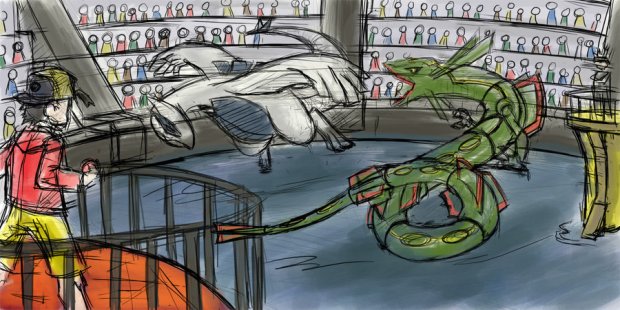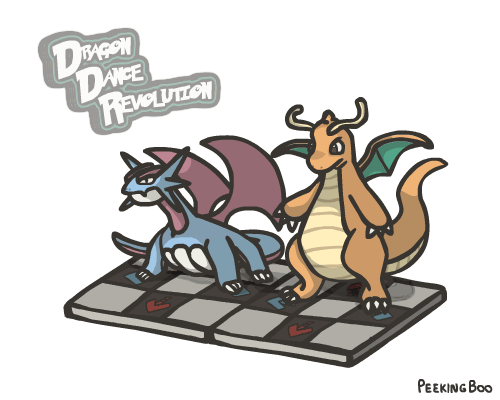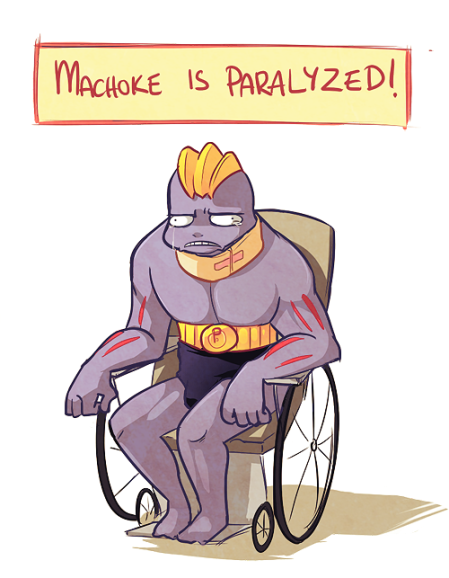Pokemon Pro-tips: A Guide to the Game you Thought you Knew (Pt. 2)
What’s up friends! I’m back with Part 2 of Pokémon Pro-tips: A Guide to the Game you Thought you Knew! If you haven’t read Part 1 of this post, I recommend that you hop over and give it a read; this part is based on the assumption that you’re already familiar with the concepts covered in my previous post, namely: Move Types, STAB, Physical & Special Moves.
Anyway, for those uninitiated to what I’m writing about here, it’s a so-called guide to the Pokémon game franchise, where I’m sharing a few fundamental but often overlooked nuggets about game mechanics with regards to Pokémon battling. Think of it as a short tuition session on how to no longer suck at Pokébattling. (I know right? Typical Singaporean.) So enough with the mish-mash, and on to business!
Growl. Leer. Harden. These moves are recognised by any player to be among the worst moves in the game, because they seem to do absolutely nothing in battle. Yes, Growl, Leer and Harden probably would rank among the crappiest moves in the game, but that isn’t to say that they do nothing. As you already know, there are 6 basic stats in Pokémon: HP, Attack, Special Attack, Defence, Special Defence, and Speed. Each Pokémon has a unique predilection towards certain stats, which results in a stat distribution that is variable between certain ranges. Stat-changing moves modify these stats during battling, instantly making a Pokémon stronger or weaker, and often mean the difference between winning and losing a battle. In battle, stat-changing moves use the term ‘stages’ to represent the magnitude of a stat change. There are a total of 6 stages in the positive and negative spectrum, and their corresponding multipliers are shown in the chart below:
As shown in the chart, when a Pokémon has a stat raised by one stage, that stat is instantly 1.5x higher, which can in certain cases mean an instant victory using that particular Pokémon. Stat modifications from in-battle moves last for as long as that particular Pokémon is kept in battle; if the Pokémon is switched out, it loses its stat changes and they will be reset to default the next time it comes into play. Hence, a Pokémon at +6 Attack can keep staying and OH-KOing every one of the opponent’s Pokémon without even needing to switch out! This is also the crux of why stat-boosting moves are inherently superior to stat-reducing moves – an opponent whose Pokémon’s stats are lowered can easily switch out and negate all the stat reductions, whereas there are very few ways for said opponent to force out the Pokémon on your of the field, which makes your stat boosts more or less permanent unless you choose to switch out.
In competitive battling, moves that raise particular stats are called setup moves, because they ‘set up’ a Pokémon to KO multiple Pokémon in a row (referred to as a sweep). In normal playthroughs, setup moves can seem like a waste of time: why would I want to waste a turn boosting my attack when I can do double the damage attacking twice? The whole point of setup moves are not to KO the current opposing Pokémon, but to KO the rest of the Pokémon after the current one has been defeated. Let’s say you have a Salamence against your opponent’s Venusaur at 20% hp. Dragon Claw will easily be able to KO Venusaur, but your opponent has a Latias in the back which out-speeds and OHKOs Salamence. By using Dragon Dance, which raises Attack and Speed by one stage against Venusaur instead of finishing it off that turn, you ensure that your Salamence is able to out-speed that Latias next turn and OHKO that too along with Venusaur, thereby beginning a sweep, or at least doing considerable damage to your opponent.
Setup moves allow for Pokémon that are originally easy to deal with to suddenly become unstoppable in the course of one or more turns, forcing players to make hard decisions in battle when facing a setup Pokémon: do you switch your Pokémon out and risk the opponent setting up? Or do you leave your Pokémon in to get KOed? Depending on your decision and the move your opponent chooses, you can either salvage your Pokémon or let another one get KOed. Below are the a few common setup moves that you might see over the course of your battling.
Dragon Dance (Raises Attack and Speed by one stage each)
Dragon Dance is one of the Pokémon’s quintessential setup moves, and also one of its most dangerous. There are two common obstacles faced by potential sweepers: a lack of power and a lack of speed. By adding +1 Attack and +1 Speed, you’re suddenly able to deal massive damage to Pokémon with higher defences and outspeed any faster Pokémon; Gyarados being able to use Dragon Dance makes it one of the premier offensive threats in competitive Pokémon.
Common Pokémon able to use this move: Dragonite, Salamence, Gyarados, Feraligatr, Charizard-X
Swords Dance (Raises Attack by two stages)
Swords dance is the equivalent of attaching a grenade launcher to your measly assault rifle. Commonly available to Pokémon with already high Attack, Swords Dance doubles the Attack stat, which in most cases means that said Pokémon can instantly plough through Pokémon with high Defence. While Dragon Dance Pokémon may sometimes lack the Attack to get past walls, Swords Dance is the perfect setup move for wallbreaking, and if the sweeper is faster than the rest of the opposing team, then the game is probably as good as over. The key weakness to Swords Dance is the fact that Speed remains unchanged, which means that faster Pokémon can easily outspeed and KO the boosted Pokémon. This is why Swords Dance is best used in conjunction with priority moves such as Bullet Punch and Aqua Jet, which bypass Speed, allowing slower Pokémon to get past faster but weaker Pokémon.
Common Pokémon able to use this move: Scizor, Breloom, Lucario, Talonflame, Terrakion, Bisharp
Nasty Plot (Raises Special Attack by two stages)
Nasty Plot is a mirror of Swords Dance on the special side, although not that many Pokémon have access to this move. As with the latter, Nasty Plot allows for powerful special sweepers to take the stage. However, unlike physical moves, there are no priority moves on the special side, which increases the difficulty of sweeping. Hence, Pokémon who can effectively use Nasty Plot are those with already high speed.
Common Pokémon able to use this move: Celebi, Thundurus-T, Mismagius
Calm Mind (Raises Special Attack and Special Defence by one stage each)
Calm Mind is a setup move that relies less on an immediate boost to offence and more on bulk. When used by Pokémon with already good defence, boosting their special defence soon makes it almost impossible for any other Pokémon to check them. When coupled with the boosts to Special Attack, most special walls soon find themselves overwhelmed by the time the set-up Pokémon gets to +2 and above. In competitive battling, its not uncommon for two opposing Calm Minders to boost alongside each other, leading to what is known as a “Calm Mind War”. These instances are usually stalemates that can only be broken by critical hits (that bypass stat modifiers), leaving the victorious Pokémon vastly overpowered at +6 Sp Atk and Sp Def, easily ploughing through the remainder of the team. The most notorious Calm Mind abuser is CroCune – a Suicune that is physically defensive with a moveset of Calm Mind, Scald, Rest, Sleep Talk. This Suicune build was created by user Cromat, and quickly spread through the competitive scene; teams that relied only on speedy offence or passive defence soon found themselves overwhelmed by the seemingly undying Suicune that kept Calm Minding and recovering hp by Resting. When facing a Calm Mind Pokémon, it’s often best to switch out immediately to a strong physical attacker to scare it out before it acquires enough boosts to destroy your team.
Common Pokémon able to use this move: Latias, Suicune, Clefable, Azelf, Keldeo, Celebi
Bulk Up (Raises Attack and Defence by one stage each)
As the physical counterpart to Calm Mind, Bulk Up is commonly used by physical attackers with decent bulk (i.e. tankers). Although the effects of Bulk Up mirrors that of Calm Mind, one key shortcoming is that unlike the latter, Bulk Up users have restricted access to recovery moves, which hampers their longevity in battle. As such, Bulk Up is most effectively used by physical attackers with access to recovery moves such as Drain Punch and Rest; the former move enabling one to attack and recover hp in the same turn.
Common Pokémon able to use this move: Toxicroak, Hariyama, Scrafty
Agility / Rock Polish (Raises Speed by two stages)
What happens when you have a Pokémon with extremely high Attack / Special Attack, but lower-than average speed? More often than not, after getting off one good hit, you proceed to get outsped by everything and KOed before anything can even be done. In such cases, this is what Agility and Rock Polish are here for (they both have the same effect). One turn of boosting will suddenly transform a slow Metagross into a fearsome sweeper, and for those Pokémon already with high, will enable to outspeed even faster Pokémon such as Choice Scarf and Swift Swim users. In the DPP era, Agility Metagross, stylised as Agiligross, rose to prominence as it could outspeed most of the metagame and sweep with its power STAB Meteor Mash and Zen Headbutt. (Although the introduction of its Mega Evolution gave it a significant increase in speed that rendered Agiligross irrelevant.)
Common Pokémon able to use this move: Metagross, Landorus-T, Terrakion, Rhyperior, Mega Ampharos
Shell Smash (Raises Attack, Special Attack and Speed by two stages, while lowering Defence and Special Defence by one stage)
The Super Saiyan mode of setup moves. In one turn, Shell Smash users acquire the equivalent boosts of a Swords Dance, Nasty Plot, and Agility, all for the unbalanced trade-off of lowered Defence and Special Defence. With the existence of an overpowered setup move such as Shell Smash, only thing keeping the Pokémon world intact is the fact that so few Pokémon are able to use it. Cloyster is one of them, and while in the past it was regarded as a decent defensive wall, receiving Shell Smash in BW transformed it into a fearsome sweeper that made sure everyone had a Rotom-W or Skarmory on their team.
Common Pokémon able to use this move: Cloyster, Barbaracle, Gorebyss, Omastar
Baton Pass (The user switches out, passing on all stat changes and some special conditions)
While not strictly a setup move, Baton Pass is a very interesting move that enables stat boosts to be passed on to other Pokémon; in fact, it’s the only way for stat boosts to transfer during switching. Common Pokémon that use this move are Celebi, Espeon, Scolipede, Ninjask, and Gorebyss (Baton Pass + Shell Smash = GG). When used well, Baton Pass can allow one sweeper facing an unbreakable wall to pass its stat boosts to another Pokémon more capable of dealing with said wall, keeping the offensive momentum going. In some competitive formats, Baton-Passing teams, which feature an entire team of Baton Pass users, have been banned for being overpowered and uncompetitive. With Baton Pass, even a Metapod can transform into a fearsome sweeper, as shown in the video below:
The set-up moves that I’ve covered are only the more common (and useful) ones; for a more in-depth look at stat boosting and setup moves, check out Bulbapedia, one of the best resources for Pokémon nerds.
With the existence of setup moves and their game-winning potential, it’s only natural for counters and checks to exist; otherwise, Pokémon battling would just consist of Swords Dance and Calm Mind wars. There are various ways to deal with setup sweepers, and here are some of them:
Status Effects
One of the most effective ways to stop a sweep is by inflicting status effects upon the sweeping Pokémon. For physical attackers, burn (BRN) effectively halves their attack, Crippling Dragon Dance and Swords Dance users. Will-o-Wisp is the most reliable burning move (100% chance to burn with 85% accuracy in X/Y and 75% in BW) that is commonly used by walls such as Weezing and Sableye. Scald is also an extremely common move with the chance to burn (80 BP, 100% Accuracy, 30% Burn chance), and due to its ubiquity among water-types, physical setup sweepers often risk getting burned if they choose to set up. For special sweepers, though, burning them has only a negligible effect and is often not enough to prevent a sweep.
Paralysis (PAR) is another status effect that can halt a sweeper in its tracks, literally. The main effect of paralysis is that the afflicted Pokémon has its speed lowered to 25% of its former total, which allows practically everything to outspeed and KO the sweeper. Paralysis is most commonly induced by Thunder Wave (100% Acc), and when used in conjunction with Prankster (Ability: all non-damaging moves have +1 priority) users such as Thundurus, even sweepers at +2 Speed will find themselves suddenly useless.
Poison (PSN), in particular bad Poison can also check setup sweepers. While regular Poison reduces hp at a flat rate of 12.5% per turn, bad poison (or Toxic poison, based on the eponymous move that induces it) reduces hp at a gradually increasing rate, meaning that setup sweepers will have a much shorter sweeping time; when combined with stalling tactics such as switching around or using Protect, setup sweepers soon find themselves KOed without having done any significant damage.
Burn, Paralysis and Bad Poison are the three most reliable status afflictions that can stop a sweep, which is why most walls carry at least one of the three moves. Without these ways of crippling sweepers, defensive Pokémon such as Blissey and Umbreon would just become setup fodder for offensive Pokémon.
Hazing / Phazing
While status effects cripple setup sweepers by placing additional modifiers on the target Pokémon (i.e. Burn reduces damage output by ½), Hazing deals with setup Pokémon by directly neutralising the acquired boosts of the target Pokémon. Haze is a non-damaging move that resets all stat boosts to zero, meaning that a Pokémon at +6 Attack will find its Attack multiplier back at +0. While Haze may seem like a fantastic counter to setup moves, its weakness lies in the fact that the affected Pokémon remains on the field and is ready to set up again if the Hazer is unable to otherwise damage the opposing Pokémon. Clear Smog is a Poison-type variant of Haze with 50 Base Power.
Building upon the concept of Haze are the moves Roar and Whirlwind. These two moves force the opposing opponent to switch out to another Pokémon in the trainer’s party, which removes any stat boosts accumulated by the opposing Pokémon. The term Pseudo-Haze (or Phaze) is used to describe these two moves. Phazing is more reliable than Hazing as the distribution of phazing moves (Roar, Whirlwind, Dragon Tail) is much higher than that of Hazing moves, meaning that many good defensive Pokémon have access to them: Suicune, Empoleon, Heatran, Garchomp, Hippowdon, and Skarmory all have access to Phazing moves. The main drawback to phazing moves is that the priority for such moves is -6; barring technical details of priority order, this means that phazing moves will almost always be used go last, giving already boosted sweepers the opportunity to KO designated walls before phazing can take place. Regardless, this detail is largely irrelevant, as defensive walls usually have terrible speed and would be outsped by most offensive Pokémon.
Of course, there are many other ways to deal with setup sweepers: Taunt, Destiny Bond, Unaware, are other moves / abilities that counter stat boosting; Priority moves such as Mach Punch and Extreme Speed, or even speed-boosting items such as Choice Scarf are all methods that can hinder the opponent in setup sweeping. In the end, battling is about using the right move at the right time and predicting your opponent’s moves, and that’s where the true fun in Pokémon lies!
~~~~~~~~~~~~~~~~~~~~~~~~~~~~~~~
OK, I know I promised one last nugget, but the more I write, the more I realise that there are so many more things about Pokémon to write about. With resources such as Bulbapedia, Serebii and Smogon, it’s pointless to go into too much competitive detail with this simple guide. All I hope is to share some basic tips about Pokémon that’ll make casual battling a more exciting process, and show that contrary to what many people think, there is a serious strategic element to Pokémon battling.
If you’re interested in knowing more about the competitive scene, I highly recommend Smogon, the dominant competitive entity in Pokémon. A short disclaimer: Smogon is not an official subsidiary of Nintendo (although they have had partnerships in the past), and the rules set by Smogon on their competitive system are purely their own. That is to say that if you play on WiFi, you can use whatever Pokémon or move that you want, but on Smogon servers there are various rules to balance out the metagame. Hop onto Pokémon Showdown if you want to battle but don’t own a Nintendo DS or are lazy to breed and train all your Pokémon to perfection. Oh, and while I do sometimes play on Smogon servers, I am not affiliated to Smogon in any way, so don’t worry; this is not a shameless advert for some shady underground Pokémon battling website.
Yep, that’s all I have for now. Go forth and become a Pokémon Master!
–WQ
Images Courtesy of: Bulbapedia.net, pokemon-master, Peekingboo, Uberzers



